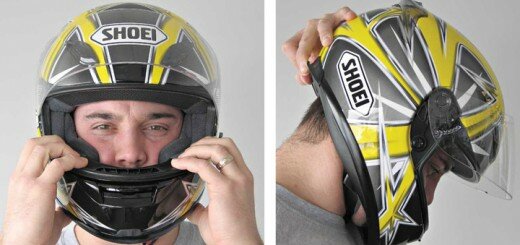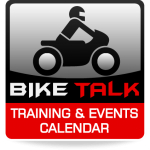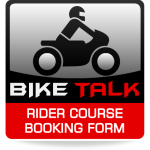Many of us firmly believe that it is unmanly for a motorcycle to lack a few scars. However, many riders seem to wish to keep their fairings unscratched, their mirrors unbent and their footpegs straight. A grasp of the basics of parking your motorcycle will aid you considerably in this aim.
No rule is absolute, but most of the following rules apply most of the time. For convenience, it is assumed that small people ride smaller bikes and big people ride bigger bikes: so, whatever your size, your bike will be pretty big in comparison to your body weight.
1. Park with your rear wheel to the curb. Most roads camber; that is, they slope down to the gutter. Also, most motorcycles only have forward gears, so the engine can only help you pull away if you are facing towards the center of the road.
2. Your tyres never sink into even the softest of ground, but metal stands can do so. Park on the sidestand. If you have the slightest worry about the surface (mud, soft tarmac, etc) you can put a ‘foot’ (plastic or metal plate, usually attached to a line for easy retrieval, and stored in a pocket on your bike when not in use), flat rock, wood or the ubiquitous flattened beer can (I mean “soft drink can”, Officer) under the side stand in such a case. It’s much harder to chock up both legs of a centerstand. Also, on the sidestand you are “three point stable” like a tripod, the center stand only gives you “two point stability”. And it’s far easier to “fine tune” the position of a ‘bike on the sidestand than it is to take it off the center stand and start again.
3. Similarly, always use the sidestand and a suitable ‘foot’ under the end of it when on camping trips. Even if the ground is rock hard when you park, rain or dew may soften it enough for the sidestand to dig in. And position the bike so that, if the stand sinks in despite your precautions, your tent with you in it will not be beneath the wreckage!
4. Park at between 90 and 45 degrees to the flow of traffic (depending how wide the road is). Parking parallel to the flow of traffic makes the bike far less visible to other road users, without reducing the actual width all that much. If you can’t park safely at 45 degrees, you probably shouldn’t park there at all.
5. Don’t leave the bike parked with the engine running. If the road is so steep that you need to leave it
in gear to stop it rolling, it is probably not the right place to leave it. (Remember; it is perfectly possible for an engine to “creep” past compression – so leaving it in gear does NOT make a good parking brake) If you have to park on a hill; park at 45 degrees to the road, with the rear tyre downhill of the front and against the curb.
6. Think before you park! Look at the ground (for the aforementioned mud or soft tarmac) and if you see a nail, don’t park on it! If you see a “No Parking” sign or marking, consider parking elsewhere. If you see ‘durban confetti’ (broken car window) consider parking elsewhere. If you see half a U-Lock and the innards of a Yamaha ignition switch, do park elsewhere!
7. If you have a choice of parking spaces (e.g.: the length of a bike bay), you should park: where the road is widest; furthest from any corner or junction; not under a tree; under a street lamp; next to a wider vehicle but not behind a vehicle that may have difficulty reversing and where the bike is easily seen (preferably by yourself or members of your household).
8. Try to leave a considerate space for other road users (‘cos they’ll only try to move the bike if you don’t). Never park in the middle of a gap that is “one and a half” cars long: it’s rude and selfish. However, you should park in the middle of a gap that is only one car long, to indicate to car drivers that they shouldn’t try to squeeze in.
9. If you possibly can, whenever you do have to move the bike under your own steam, sit astride it. If you are walking alongside a bike and have to turn or brake it sharply, it can easily fall away from you. As the bulk of the bike itself prevents you placing your feet to brace yourself, this quickly leads to the embarrassing position of you lying on top of the bike while a passing mongrel throws a bucket of water over you.
10. When you have to move a bike under muscle power, don’t let the exertion make you forget your focus. In large fleets, up to 80% of accidents happen while parking. People relax and forget to concentrate at the end of a trip. Don’t forget to check for other moving vehicles before pushing your bike across the road!
Words can not describe the feeling when you get to your bike and it’s lying on it’s side, take care parking it.










